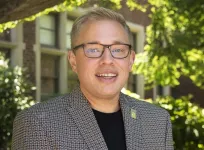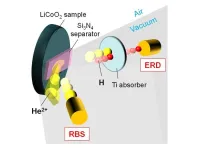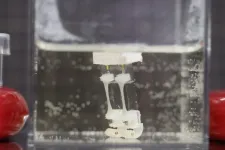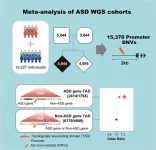(Press-News.org) JANUARY 23, 2024, NEW YORK – A Ludwig Cancer Research study has found that the circadian clock—which synchronizes physiological and cellular activities with the day-night cycle and is generally thought to be tumor suppressive—in fact has a contextually variable role in cancer.
“A lot of evidence suggests that the biological clock is broken in cancer cells, so we expected its disruption would fuel tumor growth in mouse models of melanoma,” said Chi Van Dang, scientific director of the Ludwig Institute for Cancer Research, who led the study with Research Associate Xue Zhang. “But, contrary to our expectations, we found that loss of a gene known as Bmal1—a master regulator of the cellular clock—instead dampens the growth of melanoma tumors in mice.”
The researchers’ exploration of why this is the case, described in the current issue of Nature Communications, has uncovered previously unknown mechanisms of tumor suppression and resistance to immunotherapy in melanoma.
“Our findings may have implications for the design of chronotherapies, which seek to coordinate cancer treatments with biological rhythms to improve their efficacy and mitigate their side effects,” said Zhang.
The circadian clock synchronizes the physiology of the body and the metabolism of each of its individual cells with the solar cycle, alternating phases of vibrant activity with periods of rest and recuperation. In healthy cells the intensity of metabolic activity oscillates with the biological clock. Cancer cells, however, rewire their metabolism to ensure a steady supply of the raw materials required for unrestrained proliferation. Since the periods of rest enforced by the circadian rhythms can undermine that agenda, they also tend to break their biological clocks.
The Dang lab, which has made seminal contributions to our understanding of cancer cell metabolism, has also explored links between the metabolic rewiring of cancer cells and their dysfunctional clocks. Most notably, studies led by Dang have shown that oncogenic versions of the Myc gene, a master regulator of cancer metabolism, suppress Bmal1 to disable the cell’s metabolic brakes and fuel proliferation.
The slow growth of melanoma tumors lacking Bmal1 was not consistent with that finding. Looking for an explanation, the researchers examined how gene expression changed in these cells and saw that the loss of Bmal1 compromised the activity of another master regulator of gene expression, HIF1, that helps cancer cells adapt to low-oxygen conditions prevalent in many solid tumors. They also showed that expressing HIF1 at high levels in melanoma cells that lack Bmal1 restores the ability of those cells to generate tumors.
But would Bmal1 be tumor suppressive if expressed at sufficiently high levels? Apparently not, and it turns out that this has nothing to do with Bmal1’s primary role as a regulator of gene expression. A version of the protein that could do everything ordinary Bmal1 does except bind to DNA—which it must do to regulate circadian gene expression—was an even better driver of tumor growth.
“That finding was a bit of a head-scratcher,” said Dang. “It didn’t fit with anything that we would expect.”
To solve the puzzle, the researchers conducted a sweeping analysis of protein interactions in Bmal1-overexpressing cells. They found that Bmal1 binds and sequesters a protein involved in cell motility, MYH9, that is thought to be a tumor suppressor—though how it exerts that effect was, until now, unclear. Aside from identifying the mechanism by which MYH9 suppresses tumorigenesis, the researchers show that deleting the MYH9 gene in melanoma cells boosts their ability to form tumors in mice.
Bmal1’s sequestration of MYH9 induces several changes in the molecular signaling networks of cells. Its net effect, however, is to revert melanoma cells into a developmentally immature “mesenchymal” state that is seen in human tumors and is associated with resistance to immunotherapy. Indeed, the researchers show that melanoma cells expressing high levels Bmal1 form immunotherapy-resistant tumors in the mice.
With the support of Ludwig Harvard’s Sandro Santagata and Peter Sorger, who lead the Ludwig Tumor Atlas project, the researchers employed advanced microscopy to show that tumors over-expressing Bmal1 bear molecular markers of the mesenchymal state. They also demonstrated that these tumors in mice resist immunotherapy because they are insufficiently infiltrated with immune cells that target cancer cells and tend to house immunosuppressive cells instead.
“Our findings overall show that Bmal1 drives tumorigenesis and therapeutic resistance in melanoma, suggesting that the effect of this regulatory protein on tumorigenesis most likely varies between cancer types,” said Dang. “They may also help explain a recent discovery that prostate tumors expressing Bmal1 at high levels resist androgen therapy—though that will have to be confirmed with further research.”
Beyond that, the findings have opened new avenues for research on mechanisms of tumor plasticity and cancer drug resistance that the Dang lab will now pursue.
This study was supported by Ludwig Cancer Research, the U.S. National Institutes of Health, the Sigrid Juselius Foundation, the Orion Research Foundation and the Howard Hughes Medical Institute.
Aside from his post as Scientific Director of the Ludwig Institute for Cancer Research, Dang is Bloomberg Distinguished Professor of Cancer Medicine at Johns Hopkins University.
# # #
About Ludwig Cancer Research
Ludwig Cancer Research is an international collaborative network of acclaimed scientists that has pioneered cancer research and landmark discovery for more than 50 years. Ludwig combines basic science with the translation and clinical evaluation of its discoveries to accelerate the development of new cancer diagnostics, therapies and prevention strategies. Since 1971, Ludwig has invested nearly $3 billion in life-changing science through the not-for-profit Ludwig Institute for Cancer Research and the six U.S.-based Ludwig Centers. To learn more, visit www.ludwigcancerresearch.org.
For additional information please contact communications@ludwigcancerresearch.org.
END
An assistant professor and consumer economics specialist with University of Tennessee Extension has been recognized by the Association for Financial Counseling and Planning Education (AFCPE) as the organization’s Educator of the Year for 2023. Christopher Sneed was among ten individuals, organizations, special projects and initiatives expanding access to personal finance resources and education across the country recognized as part of the 2023 AFCPE Awards late last year.
The AFCPE’s Mary Ellen Edmondson Educator of the Year Award honors ...
Boston, MA – A new review of available evidence led by researchers at the Harvard Pilgrim Health Care Institute suggests that female reproductive characteristics may be overlooked as risk factors that contribute to later metabolic dysfunction.
The review, “Reproductive risk factors across the female lifecourse and later metabolic health,” was published in the January 26 edition of Cell Metabolism.
Metabolic health is characterized by optimal blood glucose, lipids, blood pressure, and body fat. Alterations in these characteristics may lead to the development of type 2 diabetes or cardiovascular disease.
“Our ...
In the retinas of human eyes, the cones are photoreceptor cells responsible for color vision, daylight vision, and the perception of small details. As vision scientists from the Division of Experimental Retinal Therapies at the University of Pennsylvania School of Veterinary Medicine, Gustavo D. Aguirre and William A. Beltran have been working for decades to identify the basis of inherited retinal diseases. They previously showed they could recover missing cone function by reintroducing a copy of the normal gene in photoreceptor cells.
Both ...
WINSTON-SALEM, NC, January 26, 2024 – The Wake Forest Institute for Regenerative Medicine (WFIRM) is the recipient of an inaugural U.S. National Science Foundation (NSF) Engines Program award. The NSF Engines: Piedmont Triad Regenerative Medicine Engine is a regional project that provides an innovation ecosystem to stimulate workforce development, job creation, and economic growth through the development of technologies that benefit the emerging industry. The Piedmont Triad Regenerative Medicine Engine team is led by WFIRM, and includes Forsyth Technical Community College (FTCC), North Carolina Agricultural and Technical State University (N.C. A&T), the RegenMed Development ...
Lithium-ion batteries stand out as one of the most prevalent rechargeable battery technologies in the present era. Within these batteries, lithium-cobalt oxides (LiCoO2) are widely used as the materials for positive electrodes or cathodes (the conductors through which electric current either enters or exits a substance). The cathode plays a pivotal role in lithium-ion batteries and influences their capacity, performance over many charge-discharge cycles, and ability to manage heat.
One major issue leading to the deterioration of these batteries is the creation of hydrogen through the splitting of water. Therefore, gaining insights into how hydrogen builds ...
Compared to robots, human bodies are flexible, capable of fine movements, and can convert energy efficiently into movement. Drawing inspiration from human gait, researchers from Japan crafted a two-legged biohybrid robot by combining muscle tissues and artificial materials. Publishing on January 26 in the journal Matter, this method allows the robot to walk and pivot.
“Research on biohybrid robots, which are a fusion of biology and mechanics, is recently attracting attention as a new field of robotics featuring biological function,” says corresponding author Shoji Takeuchi of the University of Tokyo, Japan. “Using muscle ...
Researchers in the RIKEN Center for Brain Science (CBS) examined the genetics of autism spectrum disorder (ASD) by analyzing mutations in the genomes of individuals and their families. They discovered that a special kind of genetic mutation works differently from typical mutations in how it contributes to the condition. In essence, because of the three-dimensional structure of the genome, mutations are able to affect neighboring genes that are linked to ASD, thus explaining why ASD can occur even without direct mutations to ASD-related genes. This study appeared in the scientific journal Cell Genomics on January 26.
ASD is a group of conditions characterized in part ...
Cellular agriculture – the production of meat from cells grown in bioreactors rather than harvested from farm animals – is taking leaps in technology that are making it a more viable option for the food industry. One such leap has now been made at the Tufts University Center for Cellular Agriculture (TUCCA), led by David Kaplan, Stern Family Professor of Engineering, in which researchers have created bovine (beef) muscle cells that produce their own growth factors, a step that can significantly cut costs of production.
Growth factors, whether ...
Tisch Cancer Institute researchers discovered that a certain type of chemotherapy improves the immune system’s ability to fight off bladder cancer, particularly when combined with immunotherapy, according to a study published in Cell Reports Medicine in January.
These findings may explain why the approach, cisplatin chemotherapy, can lead to cure in a small subset of patients with metastatic, or advanced, bladder cancer. Researchers also believe that their findings could explain why clinical trials combining another type of chemotherapy, carboplatin-based chemo, with immunotherapy have not been ...
Following federal approval for over the counter emergency contraception in 2006, emergency departments across the U.S. saw dramatic decreases in related visits and medical charges, a new study suggests.
Emergency room visits related to emergency contraception fell by 96 %, from 17,019 to 659, while total related hospital expenses decreased by $7.2 million – from $7.6 million to $385,946 – between 2006 and 2020. The most notable decrease was between 2006-2007 for people primarily seen for emergency contraception.
The Michigan Medicine led findings appear in JAMA Network ...







